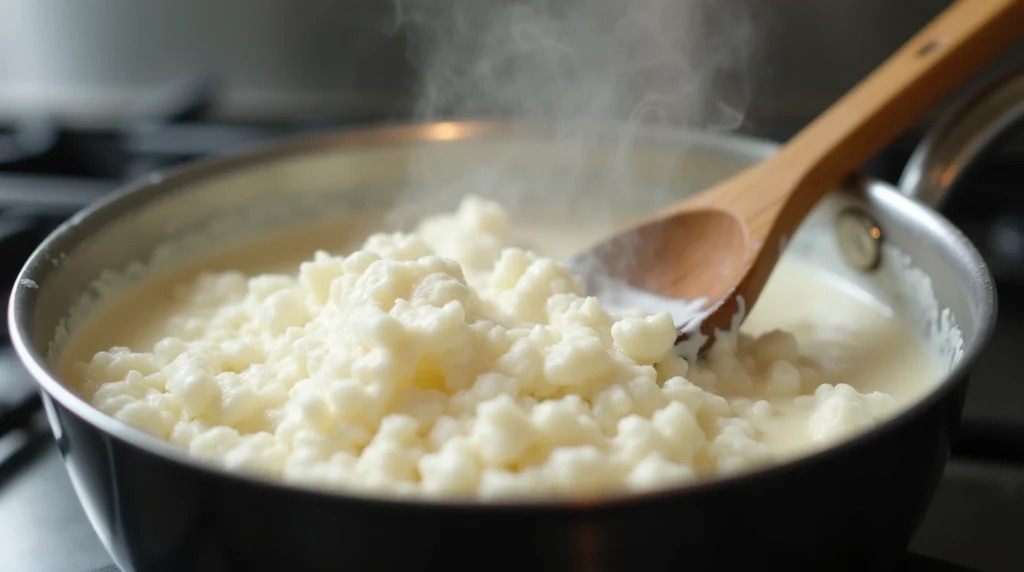Introduction
When it comes to cooking, cottage cheese often gets overlooked. Many people wonder, is it OK to melt cottage cheese? This creamy, versatile dairy product can be a fantastic addition to various dishes, but melting it can raise questions about texture, flavor, and nutritional value. In this article, we’ll explore the science behind melting cottage cheese, its culinary uses, and whether it’s a healthy choice. So, if you’ve ever pondered the idea of melting this delightful cheese, you’re in the right place!
What is Cottage Cheese?
Cottage cheese is a fresh cheese made from curds that have been drained of their whey. It’s known for its mild flavor and lumpy texture, which can vary depending on the size of the curds. Nutritionally, cottage cheese is a powerhouse. It’s packed with protein, calcium, and other essential nutrients, making it a popular choice for health-conscious individuals.
In fact, a single cup of low-fat cottage cheese can provide around 28 grams of protein, which is fantastic for muscle repair and growth. Plus, it’s low in calories, making it a great option for those watching their weight.
Purpose of the Article
The purpose of this article is to dive deep into the question, is it OK to melt cottage cheese? We’ll discuss the science behind melting cheese, explore its culinary applications, and address any health concerns you might have. Whether you’re a seasoned chef or a curious home cook, understanding how to use cottage cheese in its melted form can open up a world of delicious possibilities. So, let’s get started!
The Science of Melting Cheese

Understanding Cheese Composition
To answer the question, is it OK to melt cottage cheese?, we first need to understand what makes up this unique dairy product. Cottage cheese is primarily composed of curds and whey. The curds are the solid parts of the milk that form when it coagulates, while the whey is the liquid that remains after the curds are separated.
Unlike many other cheeses, cottage cheese has a high moisture content, which contributes to its creamy texture. This moisture is crucial when considering whether it can be melted. The composition of cottage cheese, particularly its fat and moisture levels, plays a significant role in how it behaves when heated.
In contrast to harder cheeses like cheddar or mozzarella, which melt smoothly due to their lower moisture content and higher fat levels, cottage cheese tends to become more lumpy when heated. This is because the curds do not fully melt; instead, they soften and may break apart, leading to a different texture than what you might expect from traditional melted cheese.
The Melting Process
Now, let’s delve into the melting process itself. When you heat cheese, the proteins and fats begin to change. In the case of cottage cheese, the high moisture content means that it doesn’t melt in the same way as firmer cheeses. Instead, when you apply heat, the curds soften, and the whey may separate, creating a somewhat grainy texture.
Several factors influence how well cottage cheese melts. For instance, the fat content is crucial. Full-fat cottage cheese will generally yield a creamier result compared to low-fat or non-fat varieties. Additionally, the method of heating matters. Melting cottage cheese in a microwave can lead to uneven heating, while gently warming it on the stove allows for better control over the texture.
So, while it’s technically possible to melt cottage cheese, the results may not be what you expect. It won’t create that gooey, stretchy effect you might find with other cheeses. Instead, you’ll get a softer, creamier product that can still be delicious in various dishes.
Is it OK to Melt Cottage Cheese?

Culinary Uses of Melted Cottage Cheese
So, is it OK to melt cottage cheese? Absolutely! While it may not melt in the same way as other cheeses, melted cottage cheese can still be a delightful addition to various dishes. Its creamy texture and mild flavor make it a versatile ingredient in both savory and sweet recipes.
One popular way to use melted cottage cheese is in casseroles. When baked, it can add a rich creaminess to vegetable or pasta dishes. For instance, try mixing melted cottage cheese into a vegetable lasagna for an extra layer of flavor and nutrition. It pairs beautifully with spinach, zucchini, and even mushrooms, enhancing the overall dish without overpowering it.
Another fantastic use is in sauces. You can create a creamy sauce by gently heating cottage cheese and blending it until smooth. This sauce can be drizzled over steamed vegetables or used as a base for a pasta dish. Imagine a creamy garlic sauce made with melted cottage cheese, tossed with whole-grain pasta and fresh herbs delicious!
Additionally, melted cottage cheese can be a great topping for baked potatoes or nachos. Instead of sour cream, try spooning some melted cottage cheese on top for a healthier twist. It adds protein and a creamy texture that complements the dish perfectly.
Texture and Flavor Changes
When you melt cottage cheese, you’ll notice some changes in both texture and flavor. As mentioned earlier, the curds soften, but they don’t fully melt. This results in a creamy yet slightly lumpy texture, which can be quite pleasant in certain dishes.
Flavor-wise, melting cottage cheese can enhance its natural creaminess. However, it’s essential to season it well. Adding herbs, spices, or even a splash of lemon juice can elevate the flavor profile. For example, mixing in some garlic powder and fresh chives can transform melted cottage cheese into a flavorful dip or spread.
If you’re looking to make melted cottage cheese creamier, consider blending it with a bit of milk or yogurt before heating. This can help achieve a smoother consistency, making it more suitable for sauces or as a topping.
Health Considerations

Nutritional Impact of Melting Cottage Cheese
When pondering the question, is it OK to melt cottage cheese?, it’s essential to consider the nutritional impact of this cooking method. One of the great things about cottage cheese is its impressive nutritional profile. It’s low in calories, high in protein, and a good source of calcium, making it a popular choice for those looking to maintain a healthy diet.
But does melting cottage cheese affect its nutritional value? The short answer is no melting it doesn’t significantly alter its nutritional content. The protein, calcium, and other nutrients remain intact, so you can enjoy the benefits whether you consume it raw or melted.
However, it’s worth noting that how you use melted cottage cheese can impact its overall healthiness. For instance, if you’re adding it to a rich, creamy sauce loaded with butter and cheese, the dish may become less healthy. On the other hand, incorporating melted cottage cheese into a vegetable-packed casserole or a healthy pasta dish can enhance the meal’s nutritional value.
Incorporating melted cottage cheese into your diet can be a smart choice, especially if you’re looking to boost your protein intake without adding too many calories. It’s a great way to add creaminess to dishes while keeping them nutritious.
Allergies and Intolerances
While cottage cheese is a nutritious option for many, it’s essential to consider potential allergies and intolerances. One of the most common issues people face is lactose intolerance. Cottage cheese does contain lactose, although some individuals with lactose intolerance may find they can tolerate it better than other dairy products due to its lower lactose content.
If you’re lactose intolerant, you might want to start with small amounts of melted cottage cheese to see how your body reacts. Alternatively, there are lactose-free cottage cheese options available that can provide the same creamy texture and flavor without the discomfort.
Additionally, some people may have a dairy allergy, which can lead to more severe reactions. If you have a known dairy allergy, it’s best to avoid cottage cheese altogether, whether melted or not.
In summary, melting cottage cheese is generally safe and nutritious for most people. Just be mindful of any dietary restrictions or allergies you may have. In the next part, we’ll address some frequently asked questions about melting cottage cheese to help clarify any
FAQs
Can You Melt Cottage Cheese in the Microwave?
Yes, you can melt cottage cheese in the microwave! However, it’s essential to do so carefully. Start by placing the cottage cheese in a microwave-safe bowl and heating it in short intervals, about 15 to 30 seconds at a time. Stir in between to ensure even heating. This method helps prevent overheating, which can lead to a grainy texture. Remember, melted cottage cheese won’t become gooey like other cheeses, but it will soften nicely.
What Happens if You Overheat Cottage Cheese?
Overheating cottage cheese can lead to undesirable results. If you heat it too long or at too high a temperature, the curds may become rubbery and separate from the whey, resulting in a lumpy texture. To avoid this, always heat cottage cheese gently and monitor it closely. If you notice it starting to curdle, remove it from the heat immediately.
Can You Use Melted Cottage Cheese as a Substitute for Ricotta?
Absolutely! Melted cottage cheese can be a great substitute for ricotta cheese in many recipes. While the texture may differ slightly, the flavor is mild enough that it won’t overpower your dish. For example, you can use melted cottage cheese in lasagna or stuffed pasta dishes. Just blend it until smooth for a creamier consistency, and you’ll have a delicious alternative that’s lower in fat and calories.
How Can You Make Melted Cottage Cheese Creamier?
To achieve a creamier texture when melting cottage cheese, consider blending it with a small amount of milk or yogurt before heating. This addition can help smooth out the curds and create a more cohesive mixture. Additionally, stirring in some herbs or spices while heating can enhance the flavor and make the melted cottage cheese even more enjoyable.
Is Melted Cottage Cheese Safe to Eat?
Yes, melted cottage cheese is safe to eat, provided it’s cooked properly. As with any dairy product, ensure that it’s stored correctly and consumed before its expiration date. If you’re heating it, make sure it reaches a safe temperature to kill any potential bacteria. As long as you follow these guidelines, you can enjoy melted cottage cheese without worry.
Conclusion
In this article, we’ve explored the intriguing question, is it OK to melt cottage cheese? We’ve learned that cottage cheese, with its unique composition of curds and whey, behaves differently from traditional melting cheeses. While it may not melt into a gooey, stretchy texture, it can still be a delicious and nutritious addition to various dishes when heated.
We discussed the culinary uses of melted cottage cheese, highlighting its versatility in casseroles, sauces, and as a topping for baked dishes. Additionally, we examined the nutritional impact of melting cottage cheese, confirming that its health benefits remain intact even when heated.
Moreover, we addressed potential allergies and intolerances, emphasizing the importance of being mindful of lactose intolerance and dairy allergies. Finally, we answered some frequently asked questions to clarify common concerns about melting cottage cheese.
In conclusion, melting cottage cheese is not only acceptable but can also be a delightful way to enhance your meals. With its creamy texture and mild flavor, it can elevate a variety of dishes while providing a healthy dose of protein and nutrients. So, the next time you’re in the kitchen, don’t hesitate to experiment with melted cottage cheese. Whether you’re making a comforting casserole or a creamy sauce, this versatile ingredient can help you create delicious and nutritious meals that everyone will enjoy. Happy cooking!
